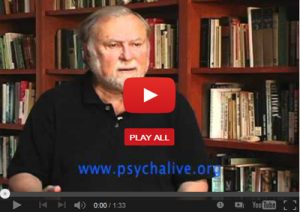The Making of a Murderer
 Years ago, when I was in the process of creating a violence assessment scale, I visited a series of high-security prisons to interview men found guilty of murder and other violent crimes. As I sat down with each inmate, the first question I always asked was, “How did you come to be a violent person?” Without fail, every single person I spoke to was quick to respond with a horrific tale of trauma in his childhood.
Years ago, when I was in the process of creating a violence assessment scale, I visited a series of high-security prisons to interview men found guilty of murder and other violent crimes. As I sat down with each inmate, the first question I always asked was, “How did you come to be a violent person?” Without fail, every single person I spoke to was quick to respond with a horrific tale of trauma in his childhood.
As a researcher, I know the dangers of using words like “every,” “all” or “always.” Of course, not every instance of violence sparks from the same source. Yet, if you look into the life of any violent individual, you are likely to see a past darkened by extreme moments of terror and suffering. Take a recent case that’s made headlines. Two episodes into HBO’s much talked about documentary series The Jinx, and we find out the main character, the heir to a rich and powerful family and suspected killer of at least three, was witness to his mother’s suicide at the age of 7. It’s deeply disturbing to watch him coldly describe how his dad told him to wave “goodnight” to his mom before she died by suicide and how, a short time later, he tried to save her from being buried at her funeral.
Not every trauma creates a killer, but most killers are created from trauma. Consider the thousands of stories that don’t make it onto our TV screens. Think of the kids who struggle with poverty, abuse or prejudice and join gangs to escape. As Father Greg Boyle, founder of Homeboy Industries who works closely with Los Angeles gang members, has said, “No kid is ever seeking anything when they join a gang. Kids are always fleeing something.” So, the question becomes, “what are they fleeing?”
From poverty to riches, serial killers to gang members, behind almost every violent person, there is a story of despair. Dr. James Garbarino, a psychologist who works with violent inmates, including many on death row, has referred to such individuals as “untreated traumatized children, inhabiting the bodies of often very scary men.” “One thing that makes them so scary is their unconsciousness about that wounded child and the anger of that child and the fear of that child. And now, in a big body, they’re doing things on behalf of that child without even an awareness of it,” said Garbarino.
While there can be a genetic predisposition to violence, genes always interact with the environment. Studies in epigenetics tell us that while our experiences don’t change our genes, they heavily influence how our genes are expressed. In other words, you can have the genetic profile of a killer without ever hurting a fly. What makes the difference is often trauma. “The typical killer is emotionally damaged and has developed mental health problems, perhaps exacerbated by being bullied and rejected by peers, or abused and neglected at home,” said Garbarino, “He might be suffering from profound sadness, depression, despair, self-aggrandizement and narcissism.”
We are all born with the neural architecture and ability to develop empathy and compassion, but for this to happen we need to have a series of positive experiences and to avoid a series of negative experiences. We must have prosocial interactions that help us to become adjusted and socialized. We also need to avoid severe, emotionally damaging events.
Traumatic events come in many forms. Experiences involving abuse and neglect can lead to violence. One study specifically found that maternal neglect and parental abuse can be large predictors of later aggression. As a society, we need to find a way to raise kids who can avoid the following key precipitators to potentially violent behavior:
1. Aggression in family – As Father Boyle suggested, most kids who join gangs are fleeing something, including abuse in their home. Many violent individuals have been witness to domestic violence. One Australian study estimated that up to 40 percent of chronically violent adolescents had witnessed extreme parental conflict. Research confirms that child abuse and the experience of family violence can be significant predictors of adult violence.
2. Early life rejection or neglect – When a child is abandoned, this can leave deep scars that are difficult for them to reconcile. Early neglect can have severe long-term consequences on brain function. In addition, rejection by a primary caretaker can make it impossible for children to form the secure attachment necessary to make them feel safe.
3. Issues in attachment style – One of the most important factors for raising emotionally healthy children involves offering them a secure attachment style. A secure attachment comes from a child experiencing what interpersonal neurobiology expert Dr. Daniel Siege calls the four S’s:
- They must feel Safe in their environment
- They must feel Seen for who they really are.
- They must feel Soothed or calmed when in distress.
- They must feel Secure.
When a child doesn’t experience these four S’s, they can develop a damaged sense of self and a destructive model for adult relationships.
4. Feelings of shame –When children are neglected, physically or verbally abused, bullied or exposed to prejudice and racism, they often feel a deep sense of shame that they carry with them in their adult lives. Some of the most impactful events that cause trauma and lead to violent tendencies involve instances of shame.
No parent can completely shield a child from painful experiences. The best of parents aren’t perfect, and perfection is not the goal. However, every child needs a caring, consistent adult who exercises a form of control that can offer the child a sense of structure and safety. Whatever conditions a child is born into, they have a basic human right to grow up in an environment where he or she can feel safe, seen, soothed and secure. As long as we fail to do this, we make our society vulnerable to future acts of violence.
If we are serious about preventing violence, we have to be serious about early intervention. We have to work together to prevent child abuse and build better mental health screening and services for younger people. If you’re worried about a child, it’s essential to seek psychological help. The earlier the intervention, the more hopeful the outcome. Having an adult who cares, be it a teacher, counselor, parent, family member or friend, can make a world of difference in a child’s life. We should never shy away or avoid the child who is different, hardened or who scares us. We must instead ask ourselves, what has so frightened this child that could make this child frightening to the world. That is where our work begins.
Join Dr. Lisa Firestone and Dr. James Garbarino for the CE Webinar “The Origins of Violence in Child Abuse.”
Tags: abuse, cause of violence, child abuse, violence, violence prevention, violent behavior









This is so true….I wish people knew this more….
A straightforward article with concise and useful content.
Though it seems glaringly obvious to some of us, one of several salient reminders mentioned in the article – for readers who are less familiar with the subject of unresolved effects of trauma and their connection, in some cases, to habitual aggression and violence:
“Not every trauma creates a killer, but most killers are created from trauma.”
All too true.
However, I find this other statement in the article problematic:
“We are all born with the neural architecture and ability to develop empathy and compassion, but for this to happen we need to have a series of positive experiences and to avoid a series of negative experiences.”
Is that really true for “all” of us?
I think not.
Can’t severe brain damage, either in utero or post-birth, to specific parts of the brain prevent, obstruct, or interfere with an individual’s “ability to develop empathy and compassion”?
Another severe example would be an individual who is clinically diagnosed as what used to be termed a “psychopath”? And this assumes that the psychopathy can also, at least in part, be empirically measured with, and evaluated based upon, current fMRI brain-scan technology?
It is well-known by informed professionals that confirmed psychopaths (incapable of natural, palpably felt remorse and empathy) tend to get that much better at deception and manipulation when they are exposed to cognitive-behavioral ‘treatment’. And where the more intelligent the CRIMINAL psychopath, the greater the danger, to innocent others, of such well-meaning, but grossly naive exposure. (And many of whom do not break the law, but are among the world’s most ‘charismatic’ and ‘successful’ leaders or public figures.)
A psychopath’s very INABILITY to feel empathy is the reason why they are so highly successful at deceiving many psychiatrists, psychologists, and others. Both professionally and personally, I know this to be exceedingly true.
I say this not to demonize anyone who is a ‘psychopath’, but to responsibly avoid deluding people with the dangerous fallacy that (especially neurologically-damaged) psychopaths can be effectively treated and cured. At least not at this time.
Also, what is the date of this article?
Standard protocol warrants an article date.
The article was published Apr 9, 2015